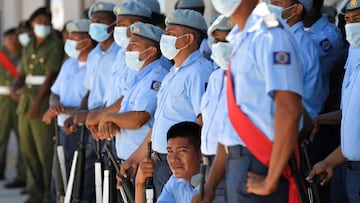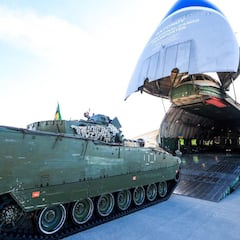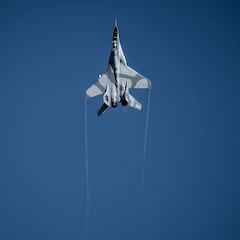Which countries have no army or military force in times of war?
Following the end of the Cold War, European armies began a process of military reduction, but there are some countries with no force to call on directly.

There are 15 countries in the world that have neither an army nor another military force to defend themselves against a potential war scenario. Given what has happened in recent weeks to Ukraine - which does have a military - we look at those who are unable to directly defend themselves if invaded.
Countries without an army
Andorra, which has signed protection treaties with both Spain and France, is one of those countries. The Andorran country has only a small army of volunteers, which is merely symbolic.
In related news:
- Canadian sniper Wali alive in interview from Ukraine
- Putin utilises control of Russian intelligence agency
- President Biden announces European trip amid Russia's invasion of Ukraine
- Theories about the mysterious 'Z' on Russian tanks in Ukraine
- Russian and Ukrainian armies compared
Another of the names on the list in Europe is Vatican City. Unlike Andorra, it has no defense treaty signed with Italy, although the Italian Armed Forces do informally protect the territory it surrounds. In security matters, Vatican City has the Pontifical Swiss Guard, which is an armed unit exclusively in charge of the protection of the Pope, so it doesn’t qualify as an army. The Swiss Guard is, moreover, under the authority of the Holy See, not Vatican City State.
Liechtenstein, known to soccer fans due to its presence in the World Cup and European Championship qualifiers, is another small country that could not defend itself in the event of war. Its government abolished the army in 1868 because it was considered too expensive. However, under an informal agreement with nearby Austria and Switzerland, both countries would provide military assistance.
The other countries that have neither an army nor a military force are Dominica (not to be confused with the Dominican Republic),Grenada, Kiribati, Marshall Islands, Federated States of Micronesia, Nauru, Palau, Solomon Islands, St. Vincent and the Grenadines, Samoa, St. Lucia and Tuvalu.
The 4 smallest landlocked countries
— World Flags (@WorldFlags7) March 22, 2022
🇻🇦 Vatican City
🇸🇲 San Marino
🇱🇮 Liechtenstein
🇦🇩 Andorra pic.twitter.com/IzVFof2ujm
Costa Rica and Iceland: no army but with a military force
Beyond these 15 countries, there are six others that also have no army but do have limited military forces.
Article 12 of the Costa Rican Constitution abolished the army as a permanent institution, although it continues to allow the organization of military forces for defense or by international agreement. Since then, Costa Rica has resorted to military force on two occasions, one in 1955 and the other in 1965.
Costa Rica has no army. https://t.co/1J7MjwrNw2
— Eb Falls (@EbFalls) March 21, 2022
Another example is Iceland, which has not had a standing army since 1869, but is an active member of the North Atlantic Treaty Organization (NATO).
Beyond these two, the other countries that plan to pull together military forces if they need them are Monaco, Panama, Mauritius and Vanuatu.
#NATO Allies are boosting their political and practical support to #Ukraine as it continues to defend itself against Russia’s full-scale invasion#StandWithUkraine🇺🇦
— NATO (@NATO) February 27, 2022
Russia, Ukraine, NATO and the rest
The current conflict between Russia and Ukraine appears like a battle between David and Goliath when comparing their militaries. The NATO alliance has said that it will not get involved but has moved forces to its eastern-most members that neighbor both nations at war. After Russia, the next four largest military forces in Europe are members of NATO. The combined strength of the 30-member alliance which includes two thirds of the European nations surpasses that of Russia in some areas but in others is on par number-wise.
Europe's largest military forces
Prior to the end of the Cold War Western European nations spent on average 2.4 percent of GDP on the military. However, by 2020 that had dropped to just 1.6 percent of GDP but the reduction in the size of each nation’s armed forces was unequal.
Germany, then just the western portion, on the front line of the Iron Curtain had the largest standing army followed by Italy, France and Britain. The picture has changed a bit since then with France possessing the largest European military force, after Russia, followed by the UK, Italy and Germany, respectively.
The downsizing of military spending occurred in Russia as well. However, around 2009 spending picked up again according to the Stockholm International Peace Research Institute (SIPRI) data.
Europe's standing armies
As a single nation Russia has the largest force of a European nation with 850,000 active personnel, or ready to deploy. They have another half million that they could call upon on short notice. However, Russia doesn't have the most troops in the world, that title goes to China. However, Russia must also protect a vast area covering around a tenth of the Earth’s land.
Ukraine has a sizeable force with 200,000 active personnel and 500,000 when reservists and paramilitary forces are included. In the current conflict the nation has called on all males 18 to 60 years old to take up arms. As well, they have handed out weapons to all citizens that wish to pitch in along with instructing the population how to make Molotov cocktails.
For comparison according to Global Firepower, France has 205,000 active personnel, the UK 194,000, Italy 170,000 and Germany 184,000. However, the combined number of troops that NATO can call on is close to 3.4 million with another 2 million reservists and paramilitary forces according to Statista.
We are ready, we are capable, we are NATO. #strongertogether pic.twitter.com/c4vQCvmhXe
— SHAPE_NATO Allied Command Operations (@SHAPE_NATO) February 26, 2022
Russia and NATO: heavy equipment
Although NATO has almost four times the number of ready to deploy troops as Russia, there is less of a gap in heavy weapons. NATO combined has around 2,300 more tanks than Russia. Nearly half of the alliance’s 14,682 tanks come from the US. Where Russia has its greatest advantage is in artillery which between stationary and mobile units including rocket launchers numbers around 17,500.
Related stories
Although they haven’t brought all their tanks and heavy equipment to Ukraine, its been estimated that roughly half the firepower Russia has was amassed along the border prior to invasion. They’ll encounter around 2,600 tanks, around 3,100 artillery fixed and mobile in addition to 490 rocket launchers in Ukraine.
How air superiority compares
Controlling the skies is critical to battlefield victory. Air superiority allows an army to be more maneuverable and to concentrate its forces. Individually the four biggest Western European air forces don’t come close to Russia’s 772 fighter jets, but NATO has a combined force of over 3,500 fighter jets. Even just the four top European NATO members have a combined 611 fighter jets they can scramble.


